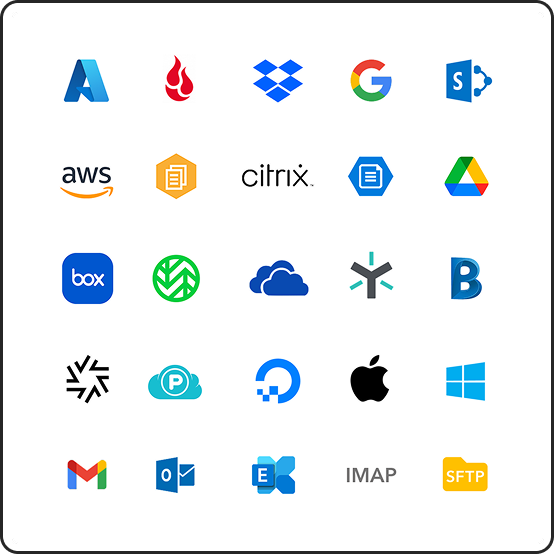There are a lot of cloud storage platforms out there. New ones appear regularly, each with their own special features that try to entice users to move over to them. But most businesses and organizations are still using a few major players such as SharePoint, Google Workspace, Dropbox, Egnyte, and Box.
But which one is right for your use case?
Depending on what you need out of a storage platform, one might be the standout choice that will give you the most benefits. Finding out which one is best, however, involves a lot of research and knowing what features are most important to the organization.
We’ve compiled a quick overview of the biggest names in cloud storage and their pros and cons so you can get an idea of which cloud storage platform is right for you and how to successfully get your data there.

Cloud storage features
Pretty much everyone uses cloud storage for the same main reason: simple storage and retrieval of files with redundancy. You don’t want to have to worry about storage space or a malfunctioning hard drive and ruin everything.
Besides that, cloud storage providers change how they handle other features depending on what type of use cases they’re targeting. Some focus on easy collaboration for teams while others are all about security and data compliance. And because of these different focuses, there are some major differences on how these features are handled.
Collaborative working
One of the main reasons cloud storage has taken off is that many of the platforms allow for collaborative working. Depending on what you’re using, you might be able to have multiple people working on the same document at the same time–even if they’re on different sides of the world.
While all of these cloud storage platforms we’re covering here let you share documents easily, not all of them are designed for working together at the same time. Instead, the focus might be on secure sharing and compliance instead of features for people to make notes and live edits simultaneously.
Compliance
In more highly regulated industries like healthcare and finance, data compliance will be at the forefront. Moving personal health information, for example, requires following HIPAA guidelines and signing a BAA with the storage company.
For some cloud storage platforms, compliance is an afterthought, while for others it comes first. If you only want to share documents with colleagues with a link, then a robust suite of compliance tools is probably overkill. But if you’re transferring detailed financial information, you need to make sure that only authorized users can access and view files.
Security
All major cloud storage providers encrypt data at rest and during transfer, but some platforms offer additional features to keep data safe. Some security features relate to sign-in, such as enforced multi-factor authentication and SSO, while others protect from malware, such as automatic backups to protect from Ransomware.
Sharing and permissions settings are more advanced in some platforms as well. All will allow users to share files and folders with specific people, but some platforms add options like expiration dates, access limits, password protection, and more. Some platforms also have active threat detection and allow you to make use of encryption keys to further safeguard important files.
Storage Space
If you’re part of a larger organization, chances are you’ll be using a lot of space. Most cloud storage providers don’t technically have a limit on the space you can have–they’ll gladly let you pay for additional space beyond their typical plans–but there are some other space limitations that might be an issue.
One of these is folder depth. Some providers don’t mind if you have folders 30 levels deep, while others have a hard limit. The same goes for the size of a single file. 100GB is the max for some platforms, while others can push 250GB or even higher. When you regularly need to move very large files, you’ll need to make sure that the storage platform can handle them.
Permission Types
It’s important to make sure the right people have access to the right files, and sometimes only the right people. You don’t want sensitive or confidential information getting in the hands of someone it isn’t meant for, and if you work in a segmented organization permissions should be an important feature to look for.
Typically, you’ll be able to share objects with people and specify who can see them. But different platforms allow for different access levels, such as read and write-only options or even private folders that require a password. There can also be different levels of drives with access levels or sub-organizations, and different sharing rules.
Storage platforms overview
There are tons of storage platforms out there, but we’ll focus on the most popular ones that businesses and teams are using today for our overviews: SharePoint, Dropbox, Google Workspace, Egnyte, and Box.
SharePoint

The most common migration we see at Movebot is organizations moving data into SharePoint. So why is SharePoint so popular and why do they keep getting more users?
The main reason we hear is the integration with Microsoft products and the whole ecosystem. For years, Microsoft Office was really the only option for high-quality work applications. Most people have used Word, Excel, and PowerPoint, especially in an office environment. And after using these programs for decades, a lot of workers get used to them and how to make the most out of them and their shortcuts and quirks.
This makes SharePoint invaluable for many organizations, especially larger, established ones that would require a lot of effort to retrain employees in new applications.
As a cloud storage platform, SharePoint is probably the most unusual of the group. Instead of User and Team drives that most platforms use, SharePoint organizes information into Sites, which they define as “a secure place to store, organize, share and access information from any device.” Sites can either be Team sites, which are private spaces for individual teams, or communication sites, meant to share information with a larger audience.
To store and share files, you’ll need to create a Site first. As part of the site creation, you can set the privacy and Sensitivity level (if you’re dealing with sensitive information) and add team members and Site Owners. Microsoft includes premade templates for common use types, or you can create a Site from scratch.
When the Site is created, you’ll need to make at least one Document Library so you can store files. The rest of the Site you can make to your liking. These Sites function like websites but with access reserved for specific members, basically a private intranet with file-sharing capabilities.
SharePoint has a lot of ways to share files. Organizations can have Hub Sites, which can connect Sites, which can have Groups, which hold individual users. Each level can have different permissions so that everyone can have access to the right information. You can then share files to these different levels depending on who needs access.
Find out more about SharePoint
Google Workspace

Another popular option, Google Workspace (Formerly G-suite) is the business version of personal Google accounts with expanded team capabilities. Google Workspace is a collection of collaboration apps including Gmail, Calendar, Chat, and more. Most relevant here is Drives, which are where files are stored for cloud storage.
Google Workspace has two types of drives: Team Drives are shared among the organization or to specific members where they have full access to everything within, and each user also has a personal drive for personal files. Files in personal drives can still be shared, but only the individual user has access to files inside their drive by default.
Organizations can make 30,000 Team Drives, each of which can be given their own sharing permissions. Create an Accounting drive only for the Accounting team, Sales and Marketing for shared resources, and so on. Each user has their own individual calendar but you can also create Group calendars for meetings and shared schedules.
Google Workspace is designed to be easy to find files you’re actively working on. Default navigation tabs in Drive include Recent and Starred, as well as Shared With Me for files shared with you that you don’t own. You can also create Workspaces for actively used files to quickly access up to 25 of your most important files located across multiple drives.
The file architecture in Google Workspace is unique. Unlike other cloud storage that has strict limits on file and folder names, Google doesn’t. You can use any character in your names, and you can even have the same file with the same name in the same place. This is great for having the freedom to name and organize files as you want, but it can lead to difficulties if you end up with files with the same name and can lead to confusion.
For collaboration, Google Workspace allows both simultaneous live editing and adding comments in their Google files. Google files are proprietary doctypes like Google Docs, Sheets, and Slides that are hosted online and can be accessed at multiple places at once. They have similar functionality to Microsoft Office files, with the catch that they’re only useable within Google unless you download them as a compatible file type.
Find out more about Google Workspace
Dropbox

Unlike Google and Microsoft who added cloud storage on top of other services, Dropbox was built solely to be a cloud storage and collaboration platform. This gives it an edge when it comes to file sharing and collaboration, but it’s also missing some other key team features like built-in calendars and live video calling.
There are a few different folder types in Dropbox, similar to Drives in other platforms. Normal folders are for individual accounts, while Shared Folders are shared with a wider group. You can also password-protect specific folders for more control.
One standout feature of Dropbox is Smart Sync, which allows users to access everything on the cloud from their computer without it taking up space. How it works is that only a tiny amount of metadata such as the file name shows up on the local hard drive, and then once the file needs to be opened, it will be downloaded to the local computer. This lets users work from their own devices and see everything on the cloud, but only use space for active files.
With the focus on collaboration, Dropbox also has powerful versioning features. Versions are saved automatically in the cloud without taking up additional storage space, and rolling back is as simple as choosing Version History and rolling back. In Business accounts, versions are kept for a year before being erased.
Dropbox has a few other useful features for collaboration as well. One of these is Dropbox Capture, a quick way to make video recordings and save them to cloud storage. Dropbox Paper is also included, designed to draft up ideas collaboratively with detailed notes about who made what changes to keep everyone on track and informed. Docs made in Dropbox Paper use a special .paper file type though, so aren’t usable outside of Dropbox.
Find out more about Dropbox Business
Egnyte

Focused entirely on businesses and enterprises, Egnyte is a cloud storage solution designed to help organizations store files and securely share them among the team. Some of these features include issue detection like monitoring for suspicious activity, access governance controls with granular permissions, data compliance, and options to watermark files.
For file sharing and collaboration, Egnyte has the essential features like the option to access files from any device, simultaneous document editing, and commenting. They also have Approval workflows built in, which can be customized to send approval requests to specific people for approval or rejection. This goes a step further for certain industries like Life Sciences that require digital signature approvals to meet GxP standards. For file sizes, they have a 100GB single file limit across all plans.
When it comes to sensitive industries like Life Sciences and Finance, Egnyte takes an unusual approach by having specialists focused on everything to keep data secure and compliant in the industry. Prospective users in these industries can chat with a specialist before sign up, and Egnyte has predefined industry compliance patterns along with regional compliance so organizations can meet their requirements.
Egnyte has also recently added the Egnyte Content Intelligence Engine, using AI to generate summaries and extract key information from files. It can also generate text-based descriptions of videos and images, automatically label sensitive documents, and selectively apply DLP controls. The engine can help optimize infrastructure and identify data that could be ready for archival or deletion as well.
Find out more about Egnyte
Box

With an emphasis on security, Box is a cloud storage platform that has advanced security controls suitable for industries like healthcare, government, and finance.
For Collaboration, Box has two unique tools, Box Notes and Box Canvas. Box Notes lets users create structured plans and schedules and edit them together. Box Canvas is a virtual whiteboard that has chats, sticky notes, voting, and other tools to help teams collaborate and decide on the best project outcomes. When documents need sign-off, Box Sign lets users create digital signatures and request them from others and track the progress of sent documents.
Since security and compliance are primary focuses in Box, they have a lot of features in these areas. One is Box Shield, a section in the admin console devoted entirely to data protection and security. Box Shield can automatically classify sensitive data, detect malware, put controls on sensitive files like PII, and stop accidental sharing of information with robust customizable security policies.
Another is data retention. Box allows for comprehensive data retention policies to help meet compliance standards and protect data from deletion. They can also be set to delete data permanently once the data can’t legally be held any longer. Retention policies can be set per folder and apply to everything within, and users can create multiple retention policies to apply to folders that have different requirements.
Find out more about Box
Migrating to your new storage platform with Movebot
Whichever platform is right for your organization, you can migrate your data there quickly and easily with Movebot. Supporting migrations to Box, Egnyte, Dropbox, Google Workspace, SharePoint, and dozens more, Movebot makes moving data easy. Connecting your existing platform only takes a few steps, and you can start moving data in minutes.
Platform agnostic with over 30 platforms supported
Movebot supports moving data between over 30 storage platforms, in either direction. Along with the most popular cloud storage platforms, you can also migrate to and from on-prem file servers and NAS devices.
But files aren’t all that Movebot can handle. Emails, contacts, and calendars can be migrated too. This means if you need to do a full organization migration from one platform to another, like Google Workspace to Microsoft 365, and move files, users, and mailboxes, Movebot can do it all. And do it fast. Move terabytes per day with no infrastructure, no virtual machines, none of that. Everything is handled in the web interface, with Movebot doing all the heavy lifting for you.
If you want to see how fast and easy Movebot is for yourself, simply register for an account. Every account gets 250GB of free data to move, and you don’t have to put in a credit card, go through a sales or onboarding call, or anything else. Simply sign up, connect your platforms, and give it a try to see if Movebot is right for your project.
Register for your account now to get started.











